Mount Kilimanjaro vs Everest Base Camp: The Key Differences
When it comes to bucket-list treks, Mount Kilimanjaro and Everest Base Camp are two of the most iconic adventures in the world. Whether you're climbing Africa’s highest peak or trekking through the heart of the Himalayas, both offer an unforgettable experience and are very popular among adventurers.
However, when choosing to tackle Everest or Kilimanjaro, you need to understand the differences as they vary significantly in terms of the overall experience. Harry, one of our Operations Managers, has completed both summits and his conclusion is that Kilimanjaro is mainly about the goal, whilst Everest is about the journey!
This guide will help you compare these two epic journeys, breaking down everything from costs to physical demands and cultural encounters. By the end, you’ll have a clearer sense of which trek is best suited to your abilities, budget, and expectations. Whichever you choose - Everest Base Camp or Mount Kilimanjaro - you’re in for an incredible journey.
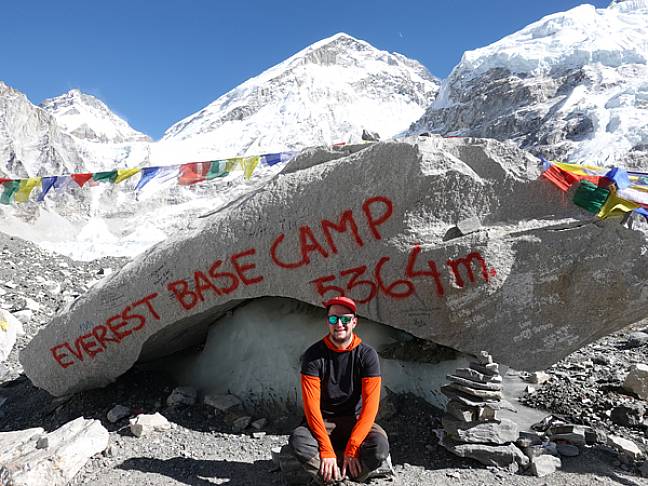
Kilimanjaro vs Everest: Which is Harder?
When it comes to deciding between Kilimanjaro and Everest Base Camp (EBC), know that both treks offer incredible experiences. However, if you're asking ‘Is climbing Kilimanjaro hard?’ or ‘Is climbing Everest hard?’ - the answer varies. Here, we’ll break down the key factors of trek difficulty - duration, physical challenges, acclimatisation, and training regimes - to help you choose your next adventure.
Duration
The trek to Everest Base Camp typically takes around 10 days, depending on your chosen route and acclimatisation stops, with a further 3-4 days required to return to the start point at Lukla. Mountain Kingdoms EBC trek takes 14 days in total including two acclimatisation days, giving us excellent success rates. The total distance is about 130 kilometres (80 miles) for the round-trip.
The total trek distance for Kilimanjaro is much shorter, between 60 - 70 kilometres (around 40miles) , but the ascent is faster so the condensed time frame makes it more intense. It is technically possible to summit Mount Kilimanjaro in as little as 4 days (on the Marangu Route), but this leaves little time to acclimatise and the failure rate is high.
Often, the people who tackle Mount Kilimanjaro via the shortest and quickest route do so for charity and are unprepared for the demands of high altitude trekking. It is much better to opt for a longer route to increase the chance of success. At Mountain Kingdoms, our Kilimanjaro summit takes the longer, more scenic, Lemosho route. This takes 8 days in total - 6 days to reach the summit and 2 days to descend - we have great success rates.
Physical Challenges
The physical demands of both climbs are significant - we grade both as ‘Strenuous’ - but they differ in style. Kilimanjaro is 5,895 metres high at the summit with 3,245m of ascent from the start of the trek. As this ascent is achieved in only 6 days, and at altitude, it is very challenging – both physically and mentally. The climb on the summit day alone of over 1,200m is particularly hard, along with the extremely steep and prolonged descent which can be ‘brutal on the knees’ according to our colleague Harry.
By way of contrast, Everest Base Camp is located at 5,545m (2,500m above the start of the trek). Although these comparative heights and the relative trek durations, make Everest Base Camp seem easier than Kili, the trek is still demanding. The undulating terrain means you’ll constantly be going up and down steep-sided hills and valleys, often on rocky, uneven paths that are hard on the legs. You’ll also be spending a lot more days and nights at higher altitude which takes its toll on the body and saps energy.
Acclimatisation
Acclimatisation is one of the most crucial aspects of both treks. As we’ve mentioned, Mount Kilimanjaro has a much shorter acclimatisation period compared to Everest Base Camp. Due to the quick ascent, many trekkers experience symptoms of altitude sickness such as nausea, breathlessness, headaches and fatigue which makes it hard to keep going. This is one of the biggest factors contributing to its lower overall success rate of around 45% (this is speaking generally, not for our treks). One way that you can improve your acclimatisation for Kilimanjaro is to complete a 'pre-trek' of the neighbouring peak of Mount Meru. At 4,556m, Meru is considerably lower than the top of Kili but is still a high-altitude trek in its own right. It requires 5 days to trek up and down and is excellent preparation for its higher neighbour. Mount Meru also offers fabulous views across to the conical peak of Kilimanjaro. Find out more about our Mount Meru & Kilimanjaro trek.
By contrast, the Everest Base Camp trek builds in more days for acclimatisation, with ‘rest’ days to adjust to the increasing altitude. Although trekkers may experience some symptoms of altitude sickness they tend to be milder, with more time to adjust the body to the thinner air. As a result, the success rate is higher at around 90% across the board.
Training Regimes
When it comes to training, both treks benefit from a good level of cardiovascular fitness and lower-body strength.
For Kilimanjaro, you’ll need to focus on stamina and leg strength, as the summit day can involve 12 to 16 hours of trekking. You have to get up at midnight to begin your journey, meaning it’ll be cold and dark, and you’ll be running on very little sleep which contributes immensely to the difficulty. Because of this, many people (including Harry) say the mental challenge of Kilimanjaro is greater than the physical one. Even once you’ve reached the top, the hard work isn’t over with the descent being extremely tough on the legs.
For these reasons, your training should be a combination of long hikes and strength-building workouts. Get your body used to steep climbs and descents if you can, and practice with using trekking poles as these will help on both the ups and the downs.
For Everest Base Camp, endurance is key. You'll ideally need to train for long days of continuous trekking (5 to 8 hours daily), often on uneven terrain. Hiking with a backpack and increasing your walking distance will help you prepare for the demands of this trek.
What’s the Verdict?
When comparing Mount Kilimanjaro vs Everest, the challenge depends on what aspect you prioritise. Kilimanjaro may be shorter in duration, but the fast ascent at high altitude makes it harder for many trekkers. Either way, whether you aim for the roof of Africa or the base of the world’s highest peak, both are unforgettable adventures that require physical preparation and mental determination.
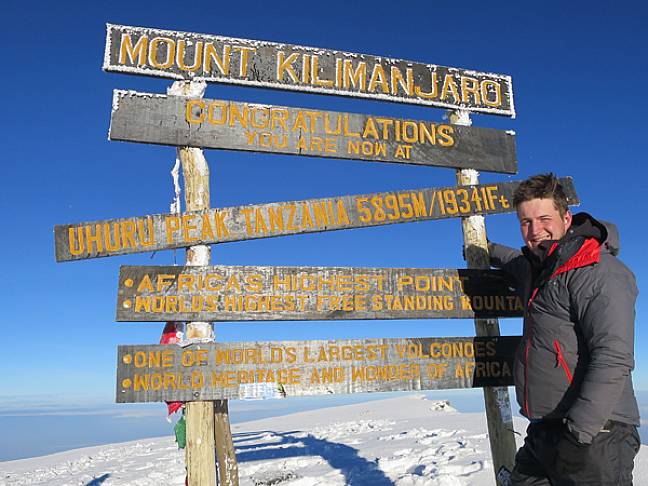
Kilimanjaro vs Everest: What Makes Them So Different?
When considering two of the most iconic trekking adventures in the world, many outdoor enthusiasts debate which is the better choice: Mount Kilimanjaro or Everest Base Camp. Both are challenging, but they differ significantly in terms of location, altitude, landscapes, culture, and overall experience. If you're wondering whether to take on Everest or Kilimanjaro, let’s dive into the details to help you decide which adventure is right for you.
Location and Altitude
Kilimanjaro
Mount Kilimanjaro is located in Tanzania, East Africa, near the border of Kenya. It’s the highest free-standing mountain in the world, towering at 5,895 metres above sea level. Despite being situated near the equator, Kilimanjaro's peak is permanently capped with snow. A trek up Kilimanjaro offers the unique experience of walking through five distinct climate zones, from tropical rainforests at the base to Arctic conditions at the summit.
Everest Base Camp
Everest Base Camp (EBC) is located in the Himalayas in Nepal, on the south side of Mount Everest. If you’re wondering how high is Everest Base Camp compared to Kilimanjaro, it’s slightly lower than Kilimanjaro’s summit, standing at 5,545 metres - an impressive altitude in its own right. And, although not a summit, reaching the foot of the highest mountain in the world at 8,848 metres, is a fantastic achievement. During the springtime, expeditions set up at EBC in preparation for their attempts to summit the mountain. This adds a whole layer of excitement to visiting base camp at this time of year.
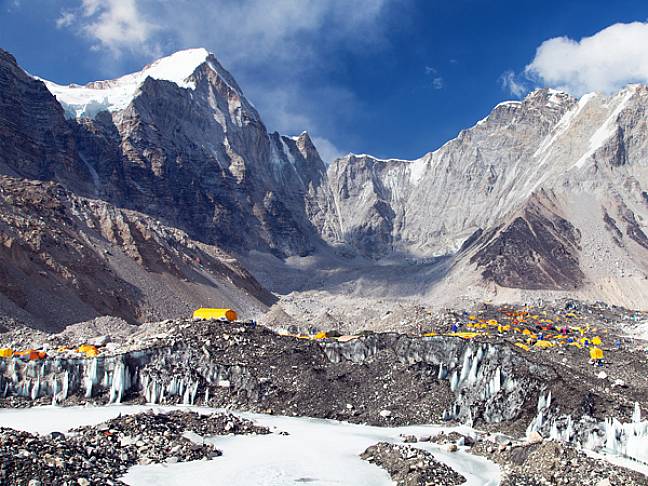
Terrain and Landscapes
Kilimanjaro
The terrain on Kilimanjaro is as diverse as it is dramatic. The trek begins in rainforests, where you can expect muddy paths and dense vegetation. As you ascend, the terrain changes to moorland and alpine desert, with rocky trails and sparse vegetation. Finally, the summit zone is harsh and barren, with loose scree slopes and ice-capped glaciers. Harry mentioned that the sunsets, sunrises and star-filled skies were particularly spectacular on Kilimanjaro.
Everest Base Camp
The Everest Base Camp trek takes you through the heart of the Khumbu (the Sherpa word for the Everest region), where the terrain is a mix of steep inclines, rocky paths, and suspension bridges over deep valleys. The landscapes every single day are breathtaking, featuring panoramic views of valleys, high peaks, traditional Sherpa villages, tea houses, and many historic sights. Some of the most notable highlights are Thyangboche Monastery, the Sherpa town of Namche Bazaar, the beautiful peak of Ama Dablam and the stone memorials to Everest explorers.
As you approach EBC, the terrain becomes more rugged and dramatic, with massive glaciers and towering peaks surrounding you. You will be trekking on the rocky debris from the Khumbu Glacier which makes walking conditions hard. While you won’t experience the dramatic ecosystem changes of Kilimanjaro, the Himalayan backdrop is nothing short of spectacular throughout the entire experience.
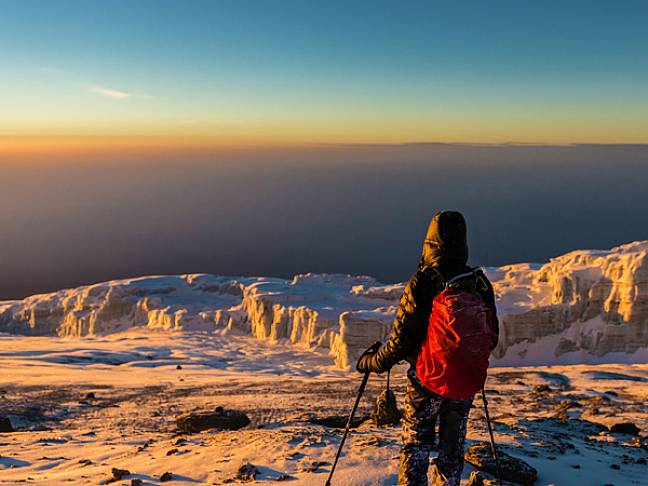
Wildlife
Kilimanjaro
On Mount Kilimanjaro, wildlife is concentrated in the lower elevations, particularly in the rainforest zone. Here, you might encounter blue monkeys, colobus monkeys, and various birds. As you ascend, the wildlife thins out, although you may still spot small mammals like hyraxes or the occasional bird of prey. The higher you go, the more barren the environment becomes, with few animals able to survive in the conditions near the summit.
Everest Base Camp
The Everest Base Camp trek offers a chance to see some unique Himalayan wildlife. You will see Himalayan Thar as well as yaks and their smaller counterpart - dzos. Dzos are a hybrid of yaks and cattle that live at lower altitudes and they, along with yaks, are commonly used to transport supplies along the trekking routes.
Bird lovers will be happy to know that you’re likely to see the colourful Himalayan monal, alongside Tibetan woodcocks, vultures, and griffins. Wildlife isn’t as abundant as in the tropical zones of Kilimanjaro, but the animals you might encounter are well-adapted to the high-altitude environment.
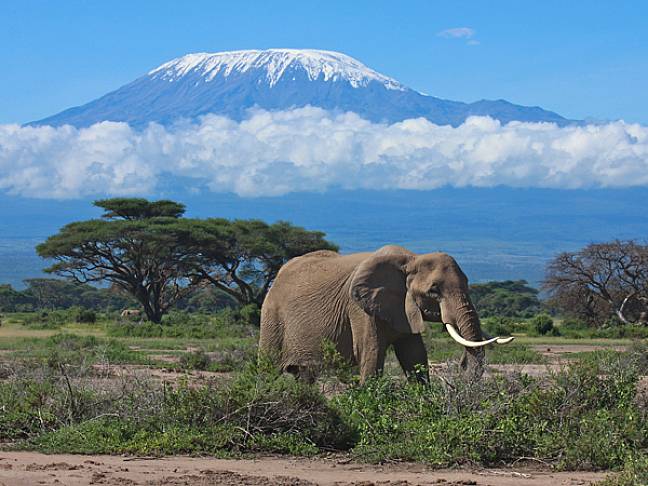
Climate and Weather Conditions
Kilimanjaro
Kilimanjaro’s climate is heavily influenced by altitude. At the base, the temperatures are warm and tropical, but they decrease significantly as you ascend. Near the summit, temperatures can plummet to well below freezing, especially at night.
The best time to climb Kilimanjaro is during the dry seasons, from December to March and from June to October, when conditions are more stable. However, weather can be unpredictable, particularly at higher altitudes, with snowstorms and high winds being possible near the summit.
Everest Base Camp
The Everest Base Camp trek also presents a wide range of weather conditions. The lower parts of the trek around Lukla are warm and sunny during the main trekking seasons, but as you gain altitude, temperatures drop noticeably - nights can be very cold when you are above 4,000m.
The best seasons for trekking to Everest Base Camp are pre-monsoon (March to May) and post-monsoon (September to November). These periods offer the clearest skies and most stable weather. You can make the trek even during the winter months our colleague, Kirsty, completed the trek over Christmas. She says that it was surprisingly warm below 3,000m in the daytime but the cold was extreme as they got towards Everest requiring careful management of water supplies and clothing. She says that it was a really magical experience though as the skies were crystal clear during the day and there were very few people sharing the trail and tea houses.
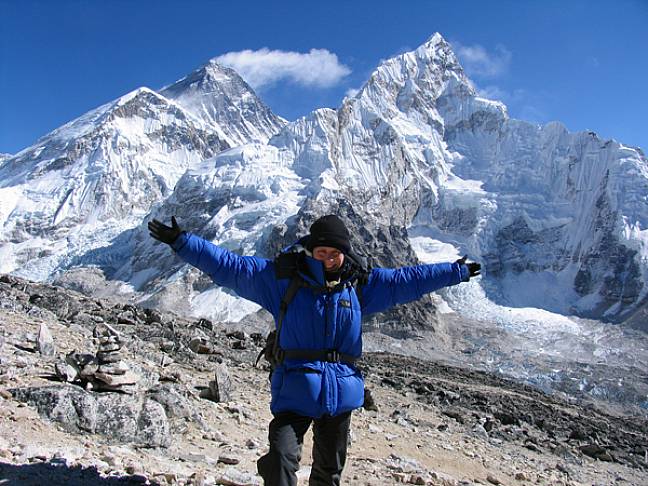
Cultural Experience
Kilimanjaro
Trekking Kilimanjaro offers a window into the culture of the Chagga people, the dominant tribe who historically lived on the slopes of the mountain. As you trek, you’ll likely interact with local porters and guides who share their traditions, songs, and stories.
Harry noted that the camaraderie when climbing Kilimanjaro was particularly strong, as everyone had a real sense of shared purpose and achievement. The guides contributed greatly to this, hosting campfire evenings and encouraging joint meals and games in the dining tent. He recalled that the guides were highly experienced and were superb at keeping the morale high. Their chant of ‘pole, pole’ (slowly, slowly) formed the rhythm of the trek and kept all the group together.
Although the trek itself is more focused on nature and wildlife, you’ll get a sense of Tanzanian culture through your guides and you’ll meet trekkers from all countries and cultures along the way.
Everest Base Camp
The cultural experience of the Everest Base Camp trek is deeply tied to the Sherpa people, who have lived in the Khumbu region for centuries. Along the route, you’ll visit traditional Sherpa villages, Buddhist monasteries, stupas, and you’ll stay in tea houses where you’ll be served dahl - a traditional Nepalese dish.
The Sherpas are known for their incredible mountaineering skills and warm hospitality, and their rich cultural traditions are an integral part of the EBC trek. This aspect adds a deeply spiritual dimension to the journey, with prayer flags fluttering in the wind and the constant presence of Tibetan Buddhism. You may also get to experience the Mani Rimdu Festival if you are lucky enough to be trekking at the right time in the autumn. This colourful, annual event is a Buddhist festival held at the Thyangboche Monastery on the route to Everest Base Camp and is attended by many Sherpa people from the Khumbu.

Accommodation and Amenities
Kilimanjaro
When climbing Kilimanjaro, you’ll be camping throughout the trek, as there are very few permanent lodges on the routes. Your crew will set up tents at designated campsites and there will also be a dining tent with tables and chairs for your group.
Meals are cooked by your trekking team and toilet facilities are generally basic - you can expect long-drop toilets to be available at camps and various other points throughout the trail. Your camp crew will also set up a private toilet tent at each overnight stop. While the camping experience brings you closer to nature, it’s far from luxurious. There’s no infrastructure like running water or electricity, so be prepared for a rugged adventure. Having said that, your crew will do a marvellous job of making meals and they will carry ample, water which they will boil for your safe use.
You will have a trek cook who will prepare you meals and you’ll be surprised at the versatility and standard of cooking from the limited range of ingredients that they carry.
Everest Base Camp
On the Everest Base Camp trek, you’ll stay in tea houses - simple lodges offering basic rooms and meals. These tea houses provide more comfort than camping, with beds, communal dining areas, and even hot showers in some locations.
While amenities are limited, especially at higher altitudes, you’ll have access to some creature comforts including a seemingly endless supply of hot tea. A typical tea house menu has a good range of choice for meals with potatoes, eggs and rice featuring prominently. You’ll notice that the local people mainly stick to eating dahl baht – a rice and lentil dish with added spices that is very filling and energising.
The atmosphere in tea houses is cosy, and they often serve as social hubs where trekkers from around the world gather to share their experiences.
If you would prefer a trek with a greater degree of home comfort, than our Everest Base Camp in Style trek may well be for you. This follows a slightly different route to the classic tea house trek but stays at good quality trekking lodges and the best available tea houses on the trail.
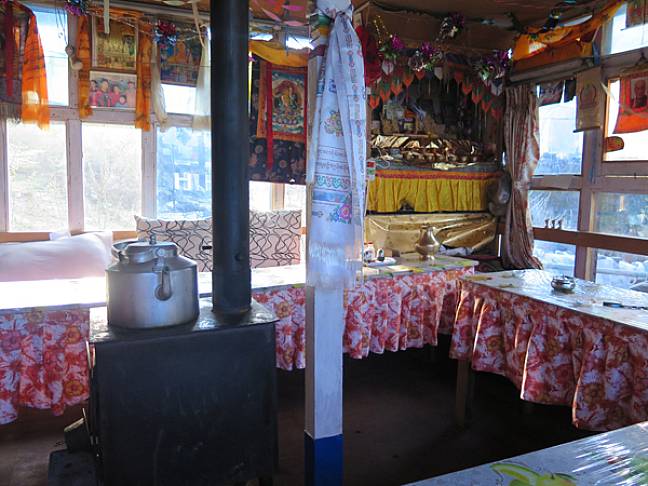
Kilimanjaro vs Everest: Costs & Logistics
When considering Mount Kilimanjaro vs Everest Base Camp it’s important to know about the different costs and logistical considerations. Ultimately, Kilimanjaro tends to be slightly more expensive due to higher permit and logistical fees.
Kilimanjaro
Climbing Mount Kilimanjaro requires a guide who is trained and licenced to lead groups along with a team of porters to carry gear and set up camp. There are also mandatory park fees which cover the use of campsites, a park maintenance fee (daily rate) and a rescue fee which is paid regardless of whether you need rescuing. The fees for the guides and porters must also be covered. The combined cost of these fees is approximately £1000 per person for the Lemosho Route. All these costs, along with meals, camping equipment and accommodation, are included in the price of your holiday with Mountain Kingdoms.
Flights to Tanzania vary, but from major hubs, you can expect to pay around £800 to £1,200. As always with flights, the sooner you book, the lower the price. Our Flights Manager, April, can provide quotes and often hold flights at a particular price if you need time to make up your mind before making a firm booking. Airport transfers to/from your hotel at the start and end of the trek are also included as standard.
The only other costs you need to consider are tips for your guide and porters (we provide advice on rates for this), the cost of a visa for visiting Tanzania and any drinks in your hotel before and after the trip. All meals are included. If you don’t have a good sleeping bag and down jacket you can hire them from us – which is far more cost effective than buying them, and you don’t need to worry about your other bedding as we supply a thick sleeping mat and pillows.
Everest Base Camp
Even though trekking to Everest is longer than climbing Kilimanjaro, the cost is lower. This is mainly due to the fact that for the Everest Base Camp trek, you only need a single entry permit for the Sagarmatha National Park. This only costs around £70 person and is obtained for you by your guide when you reach the entry point.
Guides are not mandatory for Everest, however we strongly recommend trekking with a guide and we always include a highly experienced Sherp guide and a support crew. However, given that you stay in tea houses, with meals cooked on the premises, you need a much smaller support team for Everest than for Kili.
The hire of sleeping bags and duvet jackets are included for all our Everest treks and all meals and hot drinks are provided on trek. Your additional costs are therefore just tips for the guide and crew plus any other drinks you want to buy en route. You may also be tempted to buy a souvenir or two at Namche Bazaar or treat yourself to some famous apple cake at the bakery! In Kathmandu you will stay at a good quality hotel on a bed and breakfast basis so you will need to buy a couple of meals there.
Flights to Kathmandu from London vary considerably depending on the time of year you are going and how far in advance you buy them. As with Kilimanjaro, the sooner you secure your flights the better the price. Your domestic flights between Kathmandu and Lukla are included in your holiday price along with all airport transfers.
You can view the current price of our Everest Base Camp trek here. With that said, we have many Everest Base Camp trips and holidays all with varying prices, included an ‘In Style’ version of our classic tea house trek. We can also create tailor-made itineraries which will impact the price, so it’s best to contact us directly if you’re curious.
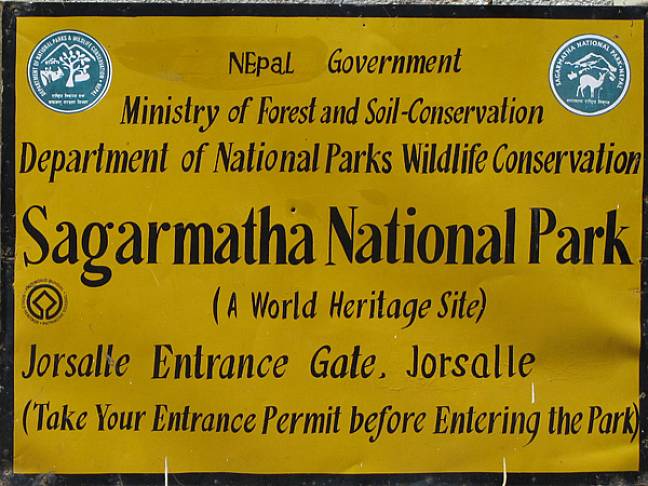
Summary
When comparing Mount Kilimanjaro vs Everest Base Camp, the key differences lie in the terrain, difficulty, and cultural experiences. Kilimanjaro offers a shorter, steeper ascent through varied ecosystems, while the Everest Base Camp trek is a longer journey through the heart of the Himalayas, with deep cultural immersion in Sherpa traditions.
Kilimanjaro is typically more physically demanding due to its rapid ascent and steep descent, while EBC provides more time for acclimatisation. Costs also vary, with Kilimanjaro generally being more expensive due to higher permit fees and trek staff costs.
Ultimately, the choice between Everest or Kilimanjaro depends on your personal goals - do you seek a challenging physical climb, a rich cultural experience, or the thrill of standing at the base of the world’s tallest mountain? Either way, as many trekkers will tell you, each adventure is immensely rewarding for different reasons, it’s up to you to decide which suits you best.
If you’re interested in tackling Everest or Kilimanjaro, Mountain Kingdoms offers a variety of different trips and routes, all led by our expert guides. If the choice is overwhelming, or you simply want to find out some more information, contact our friendly team who will be more than happy to answer any questions.
Related Blog Posts:
What is the Best Time of Year to Trek to Everest Base Camp
A Guide for Trekking to Everest Base Camp: Training & Preparation
A Guide to Trekking to Everest Base Camp: On Trek
How to Reach the Summit of Kilimanjaro
Harry Gray is one of Mountain Kingdoms leading Operations Managers with responsibility for our Kilimanjaro small group holidays and private itineraries. He also looks after the operations for several of our Everest treks. Harry has trekked extensively with Mountain Kingdoms over the many years he has been working with the company. He has summited Kilimanjaro (his first major, high-altitude trek), and reached Everest Base Camp which he achieved as part of a longer trek to the Gokyo Lakes. He has also trekked in the Langtang and Annapurna regions of Nepal including the remoted Naar Phu area.